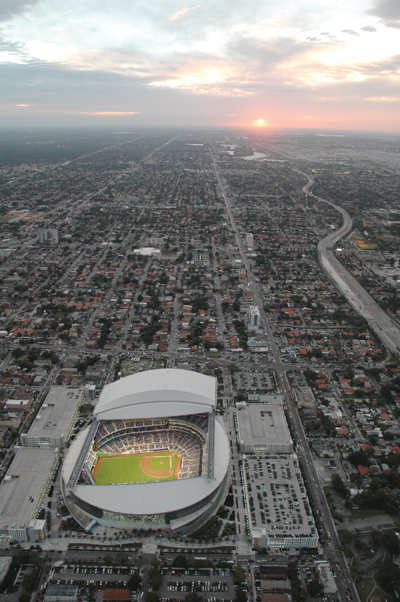SportsBusiness Journal’s David Broughton had an opportunity to ride along in Goodyear’s Spirit of Innovation blimp this spring.
The setting: The season opener for the Miami Marlins, a game that featured a national TV broadcast on ESPN2. As part of the blimp crew for the night,
Broughton was required to submit to Goodyear his name, Social Security number, driver’s license number and city of birth one month prior to the flight,
with that information passed along for screening by the Transportation Security Administration. After that, with clearance in hand, it was time for his ride. Click here for a slideshow of Broughton’s day aboard the Spirit of Innovation.
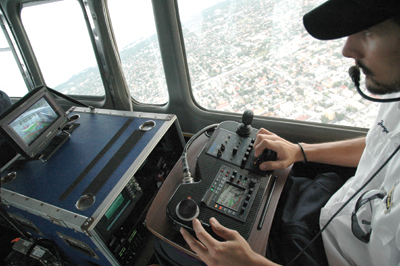 |
Goodyear cameraman Jorge Bernal stands at the controls, to gets shots of the Miami Marlins’ season opener.
All photos by: DAVID BROUGHTON / STAFF |
3:30 p.m.: I arrive at Goodyear’s facility at Pompano Beach (Fla.) Airpark. It’s an unassuming building at the local, six-runway airport, with a chain link fence (I had to be buzzed in) and a massive hangar. But if it weren’t for the sign out front that says “Blimp Base,” you’d never know it houses one of sports’ most iconic objects.
While waiting for the day’s flight crew to finish its pre-flight meeting, I spend time with Donna Calderone, the Goodyear
spokeswoman at the base. Her phone rings often, and the conversation usually goes like this:
“Yes, we are. … Hopefully around 4:30. … No, I’m sorry sweetie, you can’t today. But you are welcome to come and watch it from outside the fence.”
Calderone says the local hotel concierge frequently sends people over to watch from outside the facility. She also confirms something I had heard about before making my trip: the existence of the Helium Heads, a group of folks, largely retired military personnel, who like to drop by as if the base were a barber shop, just to talk about blimps.
With that kind of buzz for blimps, I ask her about the prospect of charging people for individual, passenger trips. Her reply: Goodyear employees from the very top to the very bottom learn early what exactly the program means to the company — and it’s not about making money.
“They could make a fortune charging folks for rides,” she says. “We did almost 1,500 rides last year, mostly for charities. This base helped raise almost $250,000 last year. But when you see what it means to those kids and those families, then you understand.”
She then introduces me to Corky Belanger, chief pilot at the base.
4 p.m.: Belanger escorts me to the hangar and shows me around as the crew prepares the ship.
Belanger has been flying for Goodyear for eight years. His dad also flew for Goodyear, doing so for more than a decade.
Up against the far back wall are the tailfins and now wrapped-up gondola of the recently retired Spirit of Goodyear ship. Belanger says the items are on their way to museums. I ask what happened to the balloon of the ship, and one of the crew members makes slashing motions, indicating they had sliced it up.
Also within sight are the vehicles for the travel crew: a bus, a nine-passenger van, and a 40-foot specially outfitted tractor-trailer rig.
4:30 p.m.: A John Deere tractor tows the massive mast attached to the 192-foot-long blimp out into the Florida afternoon. Several cars have parked outside the fence to watch the show.
I meet Mandy Martin, Spirit of Innovation’s senior pilot, who will be my tour guide for the next several hours. Martin received her Goodyear wings almost three years ago to the day and is one of three female Goodyear blimp pilots.
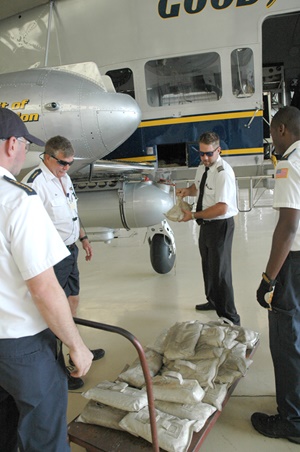 |
Sandbags are loaded in the cargo space beneath the gondola to help with weight balancing in the airship.
|
4:40 p.m.: Goodyear cameraman Jorge Bernal boards the blimp to make sure the camera and its controls are in working order, and I climb aboard a moment later. I take the seat to the right of the pilot. The cabin’s middle passenger bench has been removed to make room for the camera and the 450 pounds of rigging and equipment that go with it.
With the engines running, I watch through my open window the final phases of the preflight process. While members of the ground crew pull long ropes on either side of the ship’s nose to keep us from blowing away, their teammates load small sandbags into the cargo space beneath the gondola. Monitoring the weight, balance and center of gravity is important in any aircraft, but even more so in a vessel that is lighter than air.
5:02 p.m.: Liftoff.
As we ascend, crew members on the ground race to the sides of the ship, looking to attach the mooring ropes to each side of the blimp. The ropes are too long to just let hang free during flight because they could potentially ruin the camera view from the blimp, so they need to be fastened to the sides.
I can hear light-hearted ribbing from the ground crew members about who hooked his rope first.
We proceed to cruise south, about 900 feet above the coastline. Martin says we have a good tailwind, which is pushing us to a whopping (by blimp standards) 48 miles per hour. That means our 35-mile trip should take about an hour.
Martin spent nine years in the U.S. Air Force. She then flew blimps for MetLife on the West Coast and a since-deactivated blimp for Horizon Blue Cross Blue Shield in New Jersey for three years before joining Goodyear’s team. She had applied online for a position that simply said there was an opening to work on the “lightship aerial crew.” A couple weeks later, she got a call asking her if she was still interested in flying a blimp. She says she had no idea it was for a blimp.
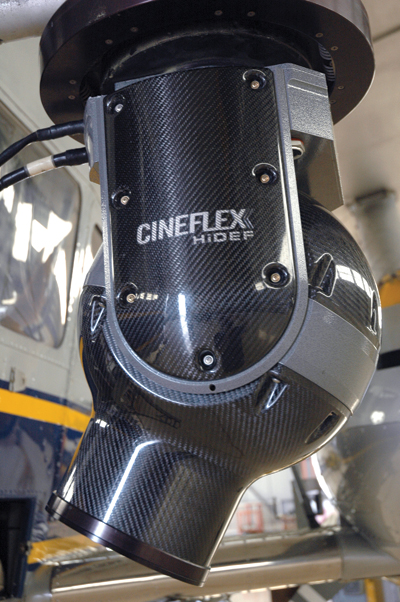 |
The Cineflex camera provides a 360-degree view.
|
“But it would be tough to fly anything else, now,” she says, looking to her left at the ocean.
5:26 p.m.: Bernal cranks the $250,000 Cineflex camera down eight feet, low enough so that none of the ship is obstructing its 360-degree view.
We fly directly over a paraglider.
5:57 p.m.: We arrive at Marlins Park.
6:02 p.m.: We are linked live with the ESPN truck on site. We can hear Matt Lipp, ESPN’s producer who’ll be running point for tonight’s game, but he can’t hear us. We can also hear constant chatter from air traffic control at Miami International Airport, which is just four miles away. Martin adjusts the headsets so that only she can hear the controller. That line of communication remains open throughout the event.
6:04 p.m.: Lipp announces to his crew setting up in the ballpark, “Hey! The blimp’s here, guys!” He immediately asks Martin to “push to the stadium” and asks Bernal what other shots he can get. We spend the next hour doing laps and searching for shots while the ESPN crew is piecing together its opening sequence that will air at 7 p.m.
“We like being used,” Martin says about the conversation with Lipp. “He sounds like he’ll use us. Sometimes, we’ll be at an event for four hours and never get used.”
“Mandy, I want you to get right down on top of the stadium,” Lipp says, just seconds later.
6:58 p.m.: Lipp and his crew finish editing the introduction, and he does a sort of roll call, wishing everyone, including Bernal, a great game.
At that moment, I may have broken some journalistic ethics. Or some blimp rules. Or maybe both. I pull out three chocolate chip cookies I had bought earlier at the Subway down the street from the base.
“Are you kidding me? No one’s ever brought us food before!” Bernal exclaims.
For the record, Martin, who is a CrossFit trainer, resisted. For about 30 seconds.
7:02 p.m.: I learn quickly that while blimps are slow, they can’t stay in one spot. Lipp asks us to zoom in on the crowd on the right field Budweiser Balcony for the broadcast’s opening “bump.” This would be the first of several times he asks for a shot, tells us it’s perfect, then says “OK. Stay there.”
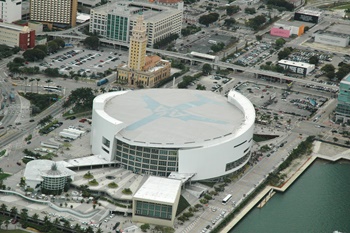 |
The Miami Heat was playing at AmericanAirlines Arena the same time of the Marlins' Opening Night game …
|
If only it were that simple. Martin can slow and pivot the ship, and Bernal can work to manipulate the camera angles, but ultimately, the blimp remains in motion, so that perfect shot and spot eventually are gone.
7:14 p.m.: With the windows in the blimp open, and the stadium roof open 1,200 feet below, the first pitch is thrown. ESPN uses our footage five times in the first hour. Throughout the game, Martin circles the stadium, often climbing several hundred feet, then turning the ship and descending
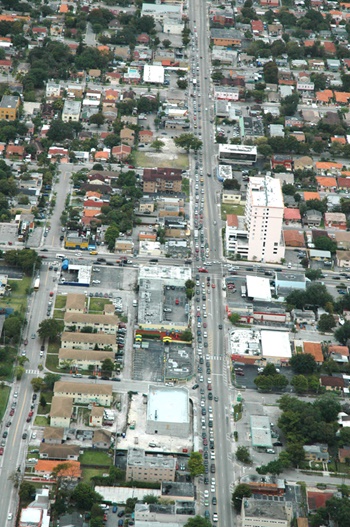 |
… leading to major traffic issues heading to the ballpark.
|
slowly, allowing Bernal to get long shots from the same angle. Similarly, Bernal is constantly maneuvering the joysticks on the camera’s control panel searching for blimp-worthy shots.
9:16 p.m.: Lipp calls for the first blimp “pop,” realizing he had not run one previously. ESPN announcer Steve Levy says live: “Thanks to Mandy Martin, our pilot tonight, and Jorge Bernal, our cameraman, from high above. Knocking it out of the park.”
10:01 p.m.: Lipp chimes in: “How about that for timing? We got the runner scoring just as we cut to the blimp overhead. Way to go Jorge! Damn, that was nice.”
10:55 p.m.: Game over. Bernal slides a panel on the back wall and empties the reserve fuel tank into the active tank by pulling a small lever. He cranks the camera back up and, using a long shepherd’s hook to reach out the window, detaches the mooring ropes so they will be ready for the crew to grab upon landing.
We head home, opting out of watching the postgame fireworks at the ballpark.
Martin turns off the EagleVision light-display system on the side of the blimp that throughout the trip had been scrolling promotions for Goodyear tires as well as messages from a few of the company’s charity partners, such as The V Foundation.
11:50 p.m.: We arrive back at base and find the ground crew lined up in a “V” formation so as to indicate the direction of the wind at ground level. The blimp lands inside the V.
We’ve burned about 70 gallons of fuel in our seven-hour flight.
Midnight: Martin says she just realized that although they bring passengers up almost daily for quick rides, she’s not sure she’s ever had a passenger for an entire sporting event. As she heads to her post-flight debriefing with the ground crew and to complete the FAA-required paperwork, she says if I bring cookies, I am welcome back any time.



